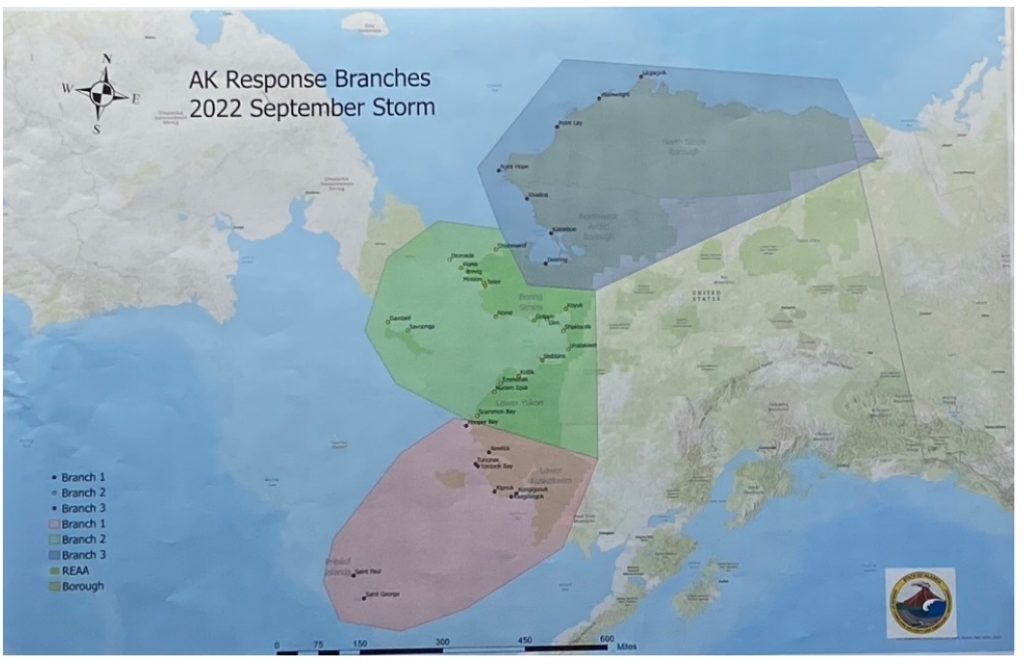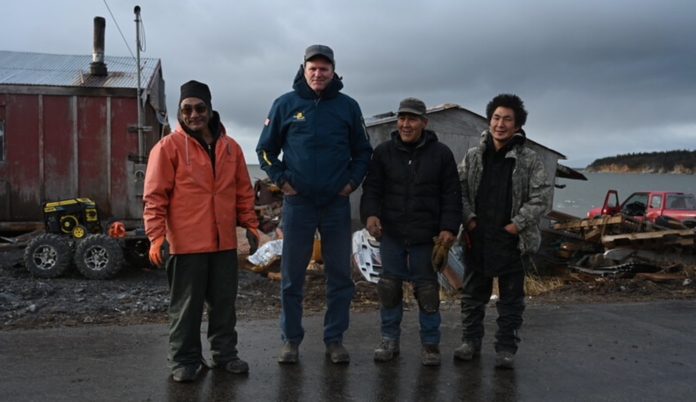Gov. Mike Dunleavy and a disaster response team returned from a four-day survey of numerous towns and villages in Western Alaska, where he has deployed over 120 personnel from the National Guard, Alaska State Defense Force, and Alaska Naval Militia Alaska to assist with materials for immediate emergency temporary residential repair and storm debris cleanup, including clearing public areas and assisting private residences. The 120 are in addition to specialists from the State of Alaska departments.
So far it appears three homes were destroyed, another 19 have major damage and three have minor damage.
The governor, Transportation Commissioner Ryan Anderson and Military and Veterans Affairs Commissioner Torrence Saxe met with local incident commanders to ensure the state is responding to all the needs of communities after the storm that hit the weekend of Sept. 17.
FEMA employees were already in the state before the storm hit, as they had flown north for disaster-related exercises with the Division of Emergency Management.
By Sept. 14, the National Weather Service started warning the state about the monster storm. FEMA employees stayed in Alaska and helped state officials with the process of notifying the communities that were in the path of the storm.
Dunleavy declared a state disaster on Sept. 17, the day the storm made landfall, and requested a federal disaster declaration on Sept. 21. President Joe Biden has yet to respond to the state’s request; his daily schedule has him focused on meetings with the Democratic National Committee and a celebration of singer Elton John.
In a similar storm in 2011, Alaska Gov. Sean Parnell declared a disaster on Nov. 5 and submitted a federal disaster declaration request on Nov. 12, approximately the same time frame. That disaster status was granted by President Barack Obama in late December of that year.
With a state disaster declaration, however, the state can proceed with making repairs to local infrastructure and ensuring shelter, food, and water for people in impacted areas. The State can dip into the legislatively pre-funded state disaster funds, and then hope the federal government will come in with funds to help and to restore the expenditure. The State of Alaska has a close working relationship with Region 10 FEMA and the head of FEMA was set to tour Western Alaska on Friday.

Alaska Department of Environmental Conservation is working on reports of local contaminant spills and water/wastewater issues in Branch I and II, the south and middle parts of the west coast of Alaska. DEC is evaluating community water systems in the storm impact area and is publishing boil water notices as appropriate. DEC has deployed a representative to the Anchorage-based USCG Incident Command Post on Thursday to coordinate assessment and clean-up efforts.
United States Coast Guard continues to survey environmental impacts in the storm area and has a ready response for search and rescue. The storm impacts have not impacted west coast communities from receiving bulk fuel deliveries with over-the-shore “soft hose” delivery available when a coastal fuel header is inoperable.
Alaska Division of Geological and Geophysical Surveys is in the storm impact area collecting high-water marks to record and calibrate the storm’s historical impact. The National Weather Service is these findings to adjust forecasting for impacted communities due to seawall and sea barrier damages.
All airports in the region have been reopened by the Alaska Department of Transportation and Public Facilities, which is working to repair roads and state facilities. Crews continue to assess roads across the impacted area, and have started drone surveys in several communities. Crews are also assisting local jurisdictions with repairs as possible.
Most of the power has been restored in Golovin and Hooper Bay, towns that were hard hit by the storm. The tanks that had tipped over in Newtok were empty. In Chevak, the Coast Guard reported approximately 1,000 gallons of fuel/oil containers strewn over about a mile of river shoreline. An oil sheen was observed and DEC is deploying to join the USCG.
United States Army Corps of Engineers has checked the Port in Nome and found no issues. Engineers are evaluating the Nome Seawall and Shismaref Bank Protection projects. The Nome Harbor Causeway Bridge has been deemed safe for passenger traffic, but some damage was observed to the rock breakwaters and the entrance channel is shoaled on the west side.
Kivalina’s revetment wall was evaluated and sustained damage to the south end. The Army Corps has 3 personnel in Nome en route to Shishmaref pending good weather and has contracted a survey team to visit St. Paul Harbor on Monday.

With twenty-two homes being damaged or destroyed, I would imagine that State appropriations to address the storm will be about $440 million. Seems about right, given rural cost differentials.
Given the season which will require all freight to be air lifted and if your learned estimate of Federal sums sought is correct we may soon find Lynden Air Cargo, NAC and perhaps Everts adding C-17’s to their fleet. If it’s modular housing maybe a C-5A?
Oh my God, a storm hit western alaska with minimal damage, let’s take more fed money for nothing. No wonder they are stealing our dividends ro protect the village vote. At least their is one person to misspell Mukowski, just like when Joe beat her fair and square
So Obama did not approve the disaster status until late December? That is extremely late and the ice is already forming, and it is winter! If the Biden administration takes that long it could be a real disaster. Governor Dunleavy has stated that there is a four week window, not four months. I hope he gets a better response.
Fortunately the damage was not much worse. Seawalls and ports are issues of navigable waters. I thought the state took over managemant of navigable waters. Why are federal tax dollars being spent here?
Thank you from the bottom of our hearts, Governor Dunleavy.
Did they not know it gets windy on the coast when they moved there? They remind us constantly they have been there for thousands of years, right?
Comments are closed.